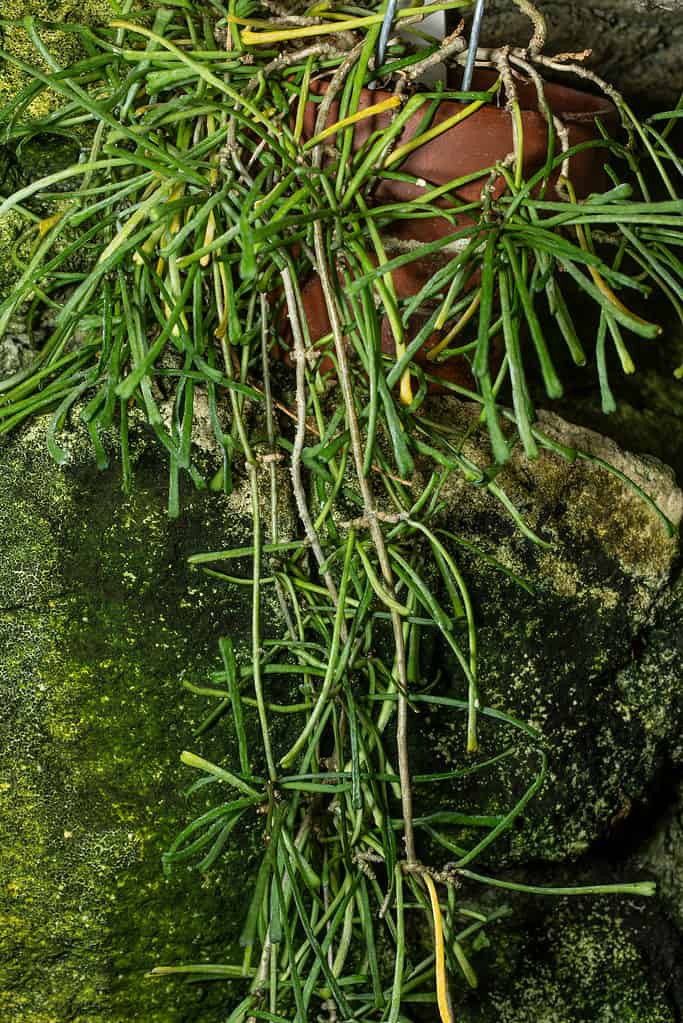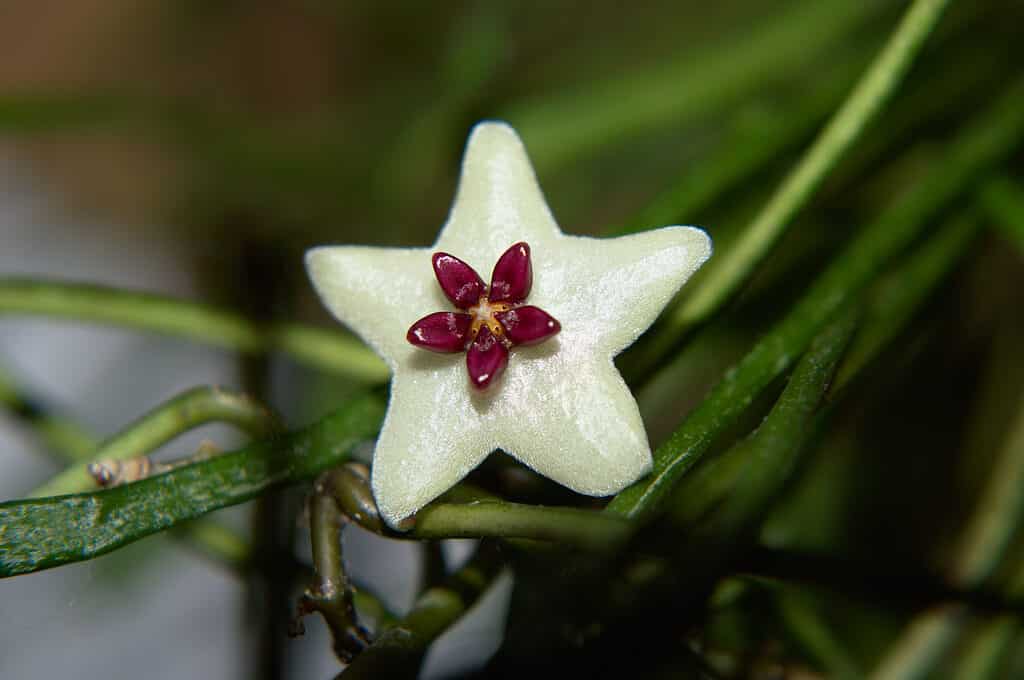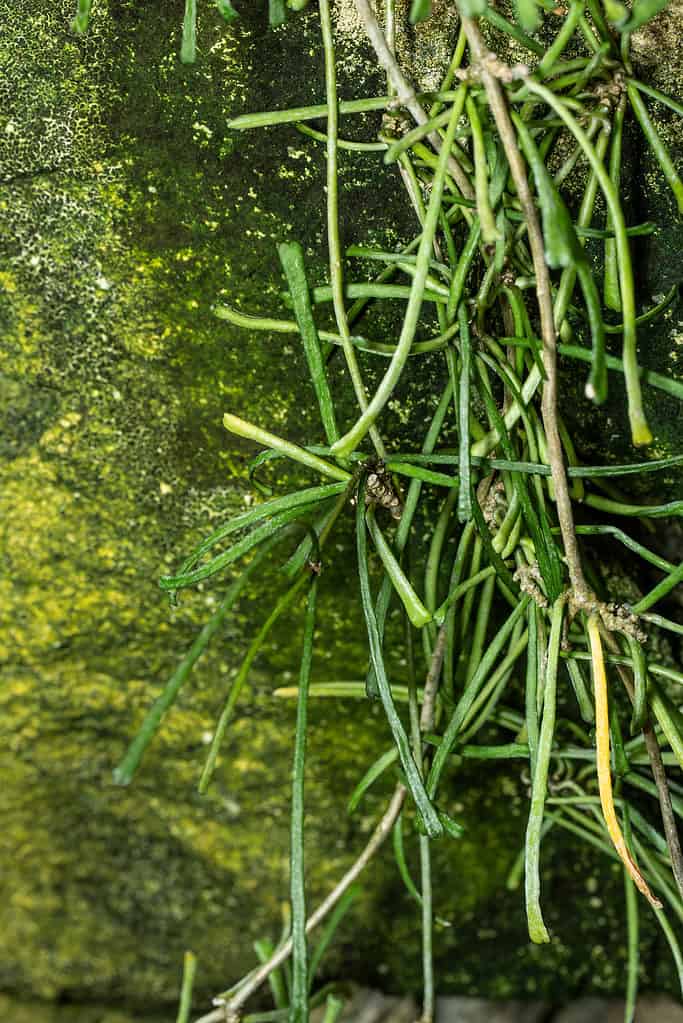Walk a little on the wild side with this unusual plant. Most hoya plants have long, trailing vines. But that is not the case with Retusa hoya. Instead, this unique plant has long, thin foliage resembling a pile of sticks. It creates an almost bushy appearance instead of vines. However, it is still a member of the Apocynaceae family. The family has hundreds of hoya plants between all the cultivars, hybrids, and various species. So you can select the perfect plant to fit your home and aesthetic.
However, this article will look at a single hoya, Hoya retusa. First, we will take a close look at this lovely plant. Then we’ll explore care tips to ensure your new hoya plant is well cared for. Finally, you will learn about its watering needs, growing medium requirements, and humidity and temperature needs.
| Scientific Name | Hoya retusa |
| Common Name(s) | Porcelain flower, Wax Plant |
| Plant Family | Apocynaceae |
| Native Region(s) | Eastern Himalyas and India |
| Life Cycle | Perennial |
| USDA Hardiness Zone | 10-11 |
This hoya plant is highly unique and fairly rare. Unlike many of its vining cousins, Hoya retusa does not reach great heights. It only grows around 4 to 6 inches tall. However, it develops a decent spread, reaching up to 24 inches.
Keep reading to learn more about Hoya retusa. We will discover what makes this hoya plant different before diving into how to care for it.
Hoya retusa Leaves
Most hoya leaves have a glossy or waxy appearance and a clear leaf appearance. Hoya retusa is not like that. This particular hoya plant has shockingly different leaves. They are long and thin and look very much like sticks. The narrow leaves get jumbled together to develop a slightly messy-looking plant. It is a truly distinctive hoya.

foliage is long and slender. It almost looks like a huge pile of sticks.
©K Hanley CHDPhoto/Shutterstock.com
Hoya retusa Flowers
All hoya plants make you wait for their stunning blossoms. Flowers won’t appear for at least two to three years. But Hoya retusa’s flowers are even a little more finicky. Don’t let that deter you, though. The flowers are an absolute delight when they do finally blossom.
The flowers are white with a red center. However, one thing that makes them stand out is that they grow individually instead of as clusters like most of the plant’s cousins. One thing they do share is the captivating aroma. Hoya retusa’s flowers are highly aromatic. They will reward you with blossoms in the spring and summer.

flowers almost look like they are made of wax. They are tiny, delicate, and have contrasting colors.
©Hoya retusa foliage/Shutterstock.com
Fun Facts About Hoya retusa
Feel free to keep at least one Hoya retusa around your home if you have pets! They are pet friendly and non-toxic, so you don’t have to worry too much if your furry friend takes a curious nibble.
Caring for a Hoya retusa
Hoya plants are a fantastic first plant for beginner and seasoned gardeners alike. They are easy to take care of, don’t have too many pests or diseases, and are low-maintenance. The best part is that, with proper care, hoya plants can survive for decades. And they will reward you with tons of flower blossoms for your efforts! Now, let’s dive into some specific care instructions for Hoya retusa.
Light Requirements
To remain healthy, Hoya retusa needs at least six hours of indirect, bright sunlight. Its delicate leaves cannot take more than two hours of direct light each day. If you leave it in the sun longer than that, you run the risk of scorching its leaves.
However, the opposite is also true. If your Hoya retusa does not get enough high-quality indirect light, it will become weak and leggy and develop less foliage.
Temperature Requirements
As a tropical plant, Hoya retusa needs a specific environment. Try to maintain a temperature between 60 and 85 degrees Fahrenheit. Typically, the temperature inside buildings is just right. These beautiful plants can tolerate an occasional dip in temperature. However, don’t leave them below 55 degrees for long. Exposure to too much cold will stunt their growth.
It is also vital to pay close attention to the room’s humidity level if you plan to keep your retusa hoya in. Tropical plants require plenty of humidity, and hoyas are no different. Therefore, keep your plants in a room with a stable humidity level of 60-80 to achieve ideal growth.
Growing Requirements
Hoya retusas don’t require too much to live long, happy lives. You can plant them in hanging planters if you wish. However, since this particular variety of hoya is bushy rather than vining, it is not necessary. They will be happy in a relatively shallow container. Hoya root systems are not deep and are prone to root rot. So, keep them in smaller and shallower pots to avoid this problem. The container you select should have plenty of holes for proper drainage.
The appropriate potting medium for a Hoya retusa is nutrient-rich, airy, and well-draining. They do particularly well in soil geared to cacti and succulents. Other options worth considering are, added ceramic ball, perlite, and pumice to help aerate your soil.
Frequent fertilization is not necessary for any hoya. Instead, focus on high-quality, nitrogen-rich, water-soluble fertilizer early in the growing season. It will help develop foliage. Then, once some flower buds appear, switch to a potassium-based fertilizer to encourage beautiful blossoms. There is no need to fertilize hoyas during the winter, as the plants go dormant in cold weather.
Water Requirements
Hoya water requirements vary by season. Due to intense sunshine in the summer, the plants will need more frequent watering. Test the soil regularly by inserting your finger approximately 2″ down. Do not water if the soil is still moist at this level. However, water enough to saturate the soil if it is dry.
In the winter, hoya plants need much less water. You can wait until the soil has completely dried out before watering during this time of year.
Propagation and Pruning
It is very easy to propagate hoyas. All you need to do is place some stem cuttings in water. The moist environment will help a new root system develop.
Pruning is also a breeze but should happen before spring arrives. When pruning a hoya plant, cut away areas that did not have flower blossoms. Hoya flowers come back in the same spot each year, and you don’t want to lose beautiful flowers!

plants are easily propagated via stem cuttings.
©K Hanley CHDPhoto/Shutterstock.com
The photo featured at the top of this post is © Aaron Miyamoto/Shutterstock.com
FAQs (Frequently Asked Questions)
How do I get my Hoya retusa to bloom?
Provide your Hoya retusa with the right environment to encourage blooming. You want to ensure they get the right temperature – between 60-80 degrees, and plenty of humidity. Also, avoid drastic fluctuations; These lovely plants will thrive in a stable environment.
Is Hoya retusa a succulent?
Hoya retusa is a flowering plant. However, the foliage is very similar to succulents. So it helps to think of succulents when approaching plant care.
How many years does it take a hoya to flower?
The key to getting a hoya to flower is patience and dedication. Your hoya should reward you with flowers in two to three years if you provide your hoya with optimum growing conditions. However, it can take a few years longer. So don’t worry if your hoya hasn’t blossomed yet!
Thank you for reading! Have some feedback for us? Contact the AZ Animals editorial team.






